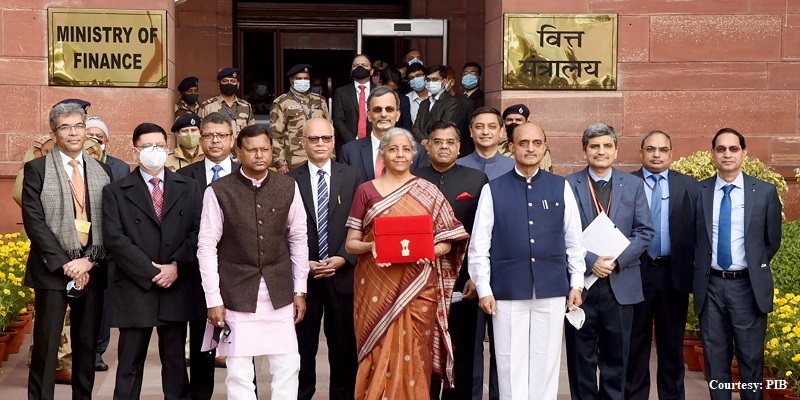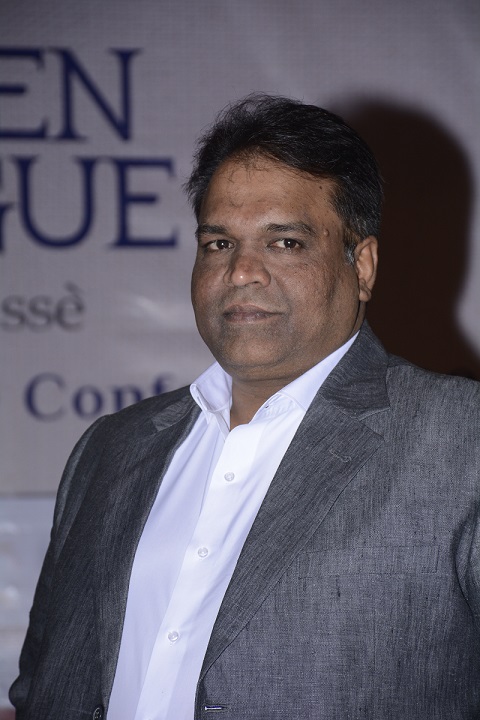
Will the budget magic work?
While budget 2022 increased allocation for the textile sector by 8.1% compared to previous year, the industry’s demand to remove 10% import duty on cotton was not met. So, will the measures announced in the budget 2022 propel industry’s growth?
India’s textile & apparels (T&A) exports during first nine months of 2021-22 increased by 52% to $30.5 billion compared with April-December 2020 period. India is now on a path to achieve $44 billion, which would be a record, exports target for 2021-22. Against this back ground, Union Finance Minister Nirmala Sitaraman presented the Budget 2022-23 to provide a fillip to the domestic textile industry. Budget has increased the allocation for the textile sector by 8.1% in FY23 compared with the revised budget allocation for FY22.

“The budget allocation for the textile sector stands at about Rs 12,382.14 crore which is about 8.1% higher than the revised budget allocation of 2021-22 which stood at about Rs 11,449.32 crores. The budget allocation during 2021-22 was initially Rs 3,631.64 crores. However, it was later revised to Rs 11,449.32 crores mainly due to an increased allocation for procurement of cotton by the Cotton Corporation of India (CCI) Ltd under price support scheme from Rs 136 crore to Rs 8,439.88 crores. For the year 2022-23, the Government has allocated about Rs 9,243.09 for procurement of cotton which is about 9.5% higher than the revised allocation of last year,” commented T Rajkumar, Chairman, Confederation of Indian Textile Industry (CITI).

“The budget will help India become a superpower in coming decades. Addressing structural issues on taxation and raw materials enhances the overall competitiveness of textile industry. This (increased allocation to CCI) will wipe out the corporation’s losses incurred for procurement of over two crore bales of cotton during the last two years that had greatly benefited the farmers to sustain the area under cotton,” opined Ravi Sam, Chairman, Southern India Mills Association (SIMA).

Budget 2022 has laid the foundation for India at 100 with the Government showing its commitment towards a sustainable and a greener future for Indians. Aimed at inclusive growth of the New India, Budget 2022-23 estimates India’s GDP growth at 9.2% which is highest among all large economies. “The Budget highlighted India’s positive growth rate of 9.2%, which is the highest among other large economies. Capital expenditure was increased by 35.4% to Rs 7.5 lakh crores as is a key driver to bringing sustainable economic revival and generating jobs for the youths,” said Vinay Thadani, Chief Financial Officer, Vishal Fabrics Ltd.
In the budget, the Government has allocated about Rs 133.83 crores for textile cluster development scheme; hence, the total budget allocation for research and capacity building for textiles has increased by 73.4% to reach about Rs 478.83 crore in 2022-23 as compared to the revised budget allocation of Rs 276.10 crore in 2021-22.
The budget has allocated Rs 100 crore for National Technical Textiles Mission and Rs 15 crore each for PM Mega Integrated Textile Region and Apparel (MITRA) parks scheme and the Production Linked Incentive (PLI) scheme. The Government has also allocated Rs 105 crore for 2022-23 towards Raw Material Supply Scheme which has already been approved for the implementation during the period 2021-22 to 2025-26.

Sanjay Jain, Chief Executive Officer, PDS Limited, said, “The retail and textile industry has been keeping a close eye on the Union Budget to propel them out of the pandemic’s afflictions. The recently announced PLI scheme for textiles, with an approved outlay of Rs 10,683 crores for five years signifies a great step forward for the industry. Although there has been a 41% increase in textile exports from April-December 2021 against last year, the measures taken can further help the sector to be more competitive with global economies. Additionally, the exemptions allowed on imports based on export performance in handicrafts, garments, and leather will work well for the industry. India’s textile industry must aim for $65 billion in exports in the next five years, especially with the China Plus One sentiments providing India a commendable position as global companies look at sourcing and manufacturing destinations outside of China.”
Focus on MSMEs

Budget 2022 also emphasised on the PM GatiShakti National Master Plan which encompasses the seven engines for economic transformation, seamless multimodal connectivity and logistics efficiency. The seven engines that drive PM GatiShakti are Roads, Railways, Airports, Ports, Mass Transport, Waterways and Logistics Infrastructure. Prashant Agarwal, Managing Director, BRFL Textiles Pvt Ltd, said, “We welcome the government’s decision of implementing the initiatives under the GatiShakti scheme which will help in enhancing logistical connectivity across the country through multimodal logistics parks which will help in the movement of goods more efficiently. Special Economic Zones such as large textiles clusters, will play a significant role in the growth of the Indian textile industry, especially for exports. The production linked incentive (PLI) announced by the government for various sectors including the textile industry is expected to create over 7.5 lakhs in the next five years in the sector, which is a great sign. Additionally, the expansion of the Emergency Credit Line Guarantee Scheme by Rs 50,000 crore to Rs 5 Lakh crores will enable MSMEs in the sector to recover from the adverse impact of the pandemic.”
To support MSMEs, the Government has extended the Emergency Credit Line Guarantee Scheme (ECLGS) up to March 2023. “The guarantee cover under ECLGS will be expanded by Rs 50,000 crore to total cover of Rs 5 lakh crore. Similarly, Rs 2 lakh crore additional credit for micro and small enterprises will be facilitated under the Credit Guarantee Trust for Micro and Small Enterprises (CGTMSE). The Government is also rolling out Raising and Accelerating MSME performance (RAMP) programme with outlay of Rs 6000 crore. All these steps will strengthen the MSME segment which holds major share in the textile & clothing sector,” said T Rajkumar.
Vinay Thadani commented, “The provision of additional allocation of Rs 50,000 crore under ECLGS will benefit more than 130 lakh MSMEs from the ECLGS and CGTMSE plan.”
However, the industry is disappointed that the enhanced allocation is not applicable to the textile sector. “Extension of the ECLG Scheme for MSMEs by a year will help the apparel industry, since many units are still struggling to overcome the adverse effects of the pandemic. However, it is unfortunate that the enhanced outlay for the scheme is restricted only for the hospitality industry – as the retail industry was as badly impacted in the pandemic. Even under the current wave, retail continues to be impacted with lockdowns, partial closures, limited working hours, etc,” said Clothing Manufacturers Association of India (CMAI) in a press release.
Ease of Doing Business 2.0
The budget announced the decisions like “Amritkaal” – the next phase of Ease of Doing Business (EODB) 2.0 – and Ease of Living which will be launched by the Government shortly. It also announced an additional allocation of Rs 19,500 crores for Production Linked Incentive for manufacturing high efficiency solar modules to meet the goal of 280 GW of installed solar power by 2030. “These actions of the Government will be fruitful for the textile industry in the coming years,” said Rajkumar.
The government is planning to replace Special Economic Zones (SEZ) Act with new legislation that will enable the states to become partner in the ‘Development of Enterprise and Service Hubs’. It will cover the existing industrial enclaves and is expected to enhance the competitiveness of India’s textile exports.
Chemistry of growth
India’s GDP is projected to grow at a historic high of 9.2% in FY2022. The chemical sector, being one of the leading contributors to the economy, has the potential to significantly help India to catapult its economy to become $ 5 trillion by 2025.

Aarti Jhunjhunwala, Executive Director of Fineotex Chemical Ltd (FCL), explained, “The speciality chemical industry being a niche segment will see a steady growth over the next few years driven by increase in domestic consumption and demand from foreign markets. The growth will further the goal of achieving GOI’s policies such as ‘Atmanirbhar Bharat’, and ‘Make in India’. The Budget 2022 has provided for the comprehensive review to simplify the customs rate and tariff structure particularly for sectors like chemicals, textiles and metals and minimise disputes. This is a welcome move. Removal of exemption on items which are or can be manufactured in India and providing concessional duties on raw material that go into manufacturing of intermediate products will go many a big step forward.”
With Budget 2022 laying greater emphasis on green energy and sustainable development, ESG related certifications amongst industries will definitely focus. “Since we are already at the forefront of the sustainability led activities, Fineotex Chemical will be able to capitalise on the same. The Budget 2022 has also announced the extension of Production Linked Incentives (PLI) Schemes to additional sectors including the textile sector. This will further boost capacities in the textile segment and thus will help the associated industries like speciality chemicals segment, to increase their capacities,” added Aarti Jhunjhunwala.

According to Rahul Tikoo, Managing Director, India Sub Continent, Huntsman International, removal of exemptions on customs levy on certain chemicals and textiles that can be manufactured in India and provision of concessional duties on raw material that are used in manufacturing of intermediate products will boost the objective of Make in India and Atmanirbhar Bharat.

The Budget 2022-23 centers on various measures to boost tech-enabled development, digital economy, climate action and energy transition. “An inclusive approach towards development to foster growth and economic recovery based on public investment and capex is highly encouraging. The focus on housing, rural development and urban planning, capex and increased investments in solar energy signal good growth prospects for the Soda ash industry as well. Overall, it is a forward-looking budget that augments greater opportunities for India Inc. and reflects the sentiments of an Atmnirbhar Bharat,” said R S Jalan, Managing Director, GHCL Ltd.
Many experts believe that the budget is progressive in nature with technology enablers across key contributory sectors. Finance Minister Nirmala Sitharaman has laid down a robust path to fast-track India towards a centenary of equality, entrepreneurial drive, and economic upliftment – with an aspiration of sharp rebound in the Indian economy at 9.2%. “Overall, the blueprint to India@100 gives a fillip to an upward growth aspiration of this nation. A capital expenditure allocation of a massive Rs 7.5 lakh crore towards digitization of the economy is a clear message to the world that New India’ inclusive and differentiated growth will lead to creation of opportunities for millions of youths, women and farmers. It also seeks a smooth transition in the country’s energy needs and commitments on climate change,” commented Rahul Tikoo.
The introduction of digital rupee by using block chain technology, focus on 5G, drone technology, clean energy are all enablers to build a sustainable, digital, and inclusive India. “A major push to free televised education through digital university under One Class-One Channel scheme is a welcome move to facilitate education for millions of students across rural India. The announcement of PM Gati Shakti program for digital multimodal connectivity will aid in creation of an agile supply chain and reduced travel time for movement of goods. This initiative along with high focus on infrastructure will help in making India competitive. One station one product concept is well thought and has a potential to be popularised to support local businesses and supply chains. Smart infrastructure spending creates a multiplier effect on the long term sustainable economic growth,” said Rahul Tikoo.
He added, “Budget 2022 has laid a strong foundation for sustainable growth through focus on clear prioritisation of public spending, infrastructure development, digital economy, improved logistics- hence, making India a competitive manufacturing destination for the world.”
Focus on technology
To incentivise exports, budget has announced exemptions on items such as embellishment, trimming, fasteners, buttons, zipper, lining material, specified leather, etc. “Exemptions are being provided to encourage exports on items such as embellishment, trimming, fasteners, buttons, zipper, lining material, specified leather, furniture fittings, and packaging boxes that may be required by bona fide exporters of handicrafts, textiles and leather garments, leather footwear, and other goods. The PLI scheme in 14 industries is expected to create 60 lakh jobs with the potential to produce 30 lakh crore in production over the next five years,” said Vinay Thadani of Vishal Fabrics Ltd.
Commenting on the budget, the Clothing Manufacturers Association of India (CMAI), said, “One bright spark of the budget specific for the apparel industry is the removal of import duty on embellishments, trimmings, buttons, etc. This has been a long-time demand of the industry and should particularly help apparel exports to become more competitive.”
At present, machinery such as knitting and weaving machines are included in the list of machines having concessional custom duty of 5%. All these machines will attract 7.5% import duty. According to Rajkumar, gradually phasing out of the concessional rates in capital goods and project imports and applying a moderate tariff of 7.5%- which is conducive to the growth of domestic sector and ‘Make in India’ – is a welcome step. Continuation of the certain exemptions for advanced machineries – that are not manufactured within the country shall – is likely to help the sector as Indian companies depend on state-of-the-art textile machineries.
Some misses
On duties levied, with no changes in the 10% import duty on cotton, the industry’s expectation of measures to control cotton prices, which is the raw material, was not met. Industry has again urged the government to exempt ELS cotton and sustainable cotton from 11% import duty as such specialty cotton is not produced in the country. “We urge the Government to allow duty free import of cotton to the actual users with some quantitative restrictions for the off season, as the country is likely to face shortage of cotton to the tune of 40 lakhs bales,” said Ravi Sam of Southern India Mills Association (SIMA).
While trimmings, embellishments, labels and the like that attract 5% import duty will now be available as duty-free imports for exporters of textiles and leather garments, it looks like made-ups and home textiles have been excluded from the duty-free import of trimmings, etc.
Beyond budget: FTAs will be the game changer
Recently, India and the UAE signed a Comprehensive Economic Partnership Agreement (CEPA) with the aim of increasing bilateral merchandise trade to $ 100 billion by 2030. Under the agreement, the UAE is set to eliminate duties on 80% of its tariff lines which account for 90% of India’s exports to the UAE by value. Currently, Indian textile and leather exports face a 5% duty in the UAE while the products of competitors in Vietnam and Bangladesh have zero duty access. CEPA will give India a competitive advantage in areas such as textiles and garments over other countries.
The agreement with UAE is the first in a series of free trade agreements (FTAs) that India is pursuing to boost exports sharply to $ 1 trillion each in merchandise and services by 2030. India is currently holding talks for FTAs with Australia, UK, Canada, Israel and the EU. The Commerce Ministry is pushing for FTAs to improve apparel exports.
For instance, before Covid, Australia was sourcing most of its apparels from China. With Australia’s relationship with China hitting a low now, India has a good opportunity to increase apparel exports to Australia as similar products are manufactured in India at similar price points. Removal of tariff barriers (via FTAs) will further enhance the prospect. Similarly, talks with the UK (a well-established market for India) are heading in the right direction.
Textile exports from India has witnessed a big surge in the first 9 months of 2021-22. One of the reasons behind the surge is the rise in sales for Indian companies to the US and Europe who have called for a ban on cotton grown in the Xinjiang province of China because of the alleged human rights abuses.
In anticipation of the positive outcomes of FTAs and growing exports, many Indian textile companies are preparing for adding capacity. For example, Texport Industries is investing $ 25 million to increase its capacity by more than a quarter over the next two years.
New technology upgradation scheme
The Union Textile Ministry is reportedly working on a new Technology Upgradation Fund Scheme, which will replace the existing Amended Technology Upgradation Fund Scheme (ATUFS). “We have formulated a new scheme. We want to bring in an element of incentivising the machinery manufacturers too,” said Upendra Prasad Singh, Textiles Secretary, while speaking at an event in the first week of February 2022.
The technology upgradation fund schemes have so far supported the textile industry. While the ATUFS did not include the spinning sector, the new scheme will include the spinning sector and the machinery manufacturers. The Union Budget proposes Rs 650 crore allocation for ATUFS for 2022-23. Approval for the new scheme is expected by March and that will come with fresh allocation of funds.
To sum up the impact of the budget, Rajkumar said, “The current Union budget does not make any direct announcement for the textile and clothing sector. However, if we see the entire budget speech in totality, it talks more about the inclusive development of the new India. The Government has already gone beyond a level and has done so much for the textile sector. It is now for India Inc to look for developing at other important aspects of the businesses like infrastructure development, liquidity, labour and power issues, availability of raw materials, ease of doing business, FTAs, technology transfer, etc to enhance the cost competitiveness of Indian products in the global market.”




